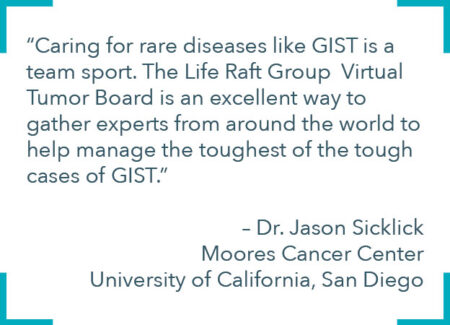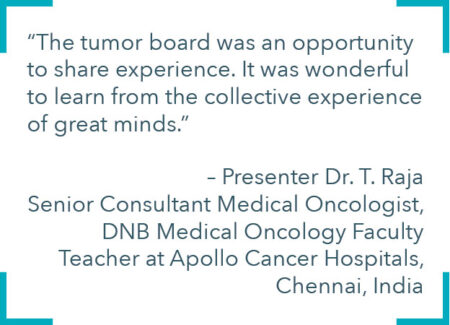PDF is available of LRG Science to print here.

An oncologist in Chennai, India, 8,366 miles away from the Life Raft Group’s Wayne, New Jersey office, is running out of treatment options for his 27-year old male GIST patient.
In Indianapolis, Indiana, only 708 miles away, options for a 41-year-old female patient with progression are waning. Additionally, her family members carry the SDHC gene mutation. Successful treatment is crucial to the preservation of this family system.
A 69-year-old male in Sweden, 3,925 miles away, was diagnosed with Wildtype GIST, and has alternated between surgeries and multiple treatment lines, experiencing progression after each intervention. Nothing seems to help. Is it really even GIST?
What connects all three of these patients?
The hope that comes from the Life Raft Group’s Virtual Tumor Board, and the fact that they are not responding to standard treatment protocols for Gastrointestinal Stromal Tumor (GIST).
 For 85% of patients diagnosed with GIST, there are highly effective treatment options available. For some patients with resectable primary tumors, surgery is the most common first step. Surgery is the gold standard for treating GIST and offers the best chance of a “cure”. Patients that are “cured” by surgery tend to be patients with a low risk of recurrence.
For 85% of patients diagnosed with GIST, there are highly effective treatment options available. For some patients with resectable primary tumors, surgery is the most common first step. Surgery is the gold standard for treating GIST and offers the best chance of a “cure”. Patients that are “cured” by surgery tend to be patients with a low risk of recurrence.
Patients with a higher risk of recurrence as well as those with metastatic disease are normally given medication to treat their GIST. There are currently three approved drugs used to treat GIST.
Initial determination of the appropriate treatment should be guided by mutational testing. Identifying the patient’s mutation prevents them from being prescribed a drug that doesn’t target their particular mutation, and that may have intolerable side effects.
Discovered as the first targeted oral chemotherapy, the first line of treatment is usually Gleevec (imatinib). It can be used to shrink a tumor before surgery (neoadjuvant), and also after surgery to delay a recurrence in the cases of high-risk GIST.
Sutent (sunitinib) and Stivarga (regorafenib) are the recommended second-line and third-line treatments for patients resistant or intolerant to Gleevec.
What about those patients who do not respond?
Some patients have responded to off-label drugs. For patients failing standard treatment, there are clinical trials. Several current trials are showing promise.
But what of the patients with rare subsets of GIST, such as SDH-Deficient, or those who may be in a geographic area where no GIST specialists are available for consultation?
Enter the Life Raft Group’s Virtual Tumor Board. In April of 2014, The Life Raft Group partnered with the National Institutes of Health to launch the first Pediatric GIST Virtual Tumor Board.
 Designed to bring together leading experts to discuss GIST cases, while serving as an educational resource for local physicians, cases are reviewed by leading experts by using secure servers for video conferencing. Participants virtually access radiology films such as CT scans and other necessary medical reports to help review the particular case and provide advice.
Designed to bring together leading experts to discuss GIST cases, while serving as an educational resource for local physicians, cases are reviewed by leading experts by using secure servers for video conferencing. Participants virtually access radiology films such as CT scans and other necessary medical reports to help review the particular case and provide advice.
To see our Virtual Tumor Board in action, you can access our video: youtube.com/watch?v=7KPFmJ2oCw0
The initial boards were so successful, that they were expanded to include adult cases.
The Life Raft Group presented an abstract about the Virtual Tumor Board at ASCO in 2017: http://ascopubs.org/doi/abs/10.1200/jco.2016.34.3_suppl.e278
The Life Raft Group was already established as a GIST patient advocacy group with global reach. New Horizons, an annual conference, gathers global representatives to exchange best practices, learn new medical and scientific information and discuss advocacy issues that impact GIST patients worldwide. Another global initiative, Salud con Datos, is a collaborative effort to build a data sharing network in Latin America. The Virtual Tumor Board is another powerful tool with global reach.

With the birth of the Pediatric and SDH-Deficient GIST Consortium as part of a Biden Cancer Initiative commitment, the pool of experts has expanded. At a Virtual Tumor Board in February 2019, the cases mentioned in the beginning of this article were reviewed by a world-class team of GIST experts from world-class institutions including Dana-Farber Cancer Institute; Memorial Sloan Kettering Cancer Center; Fox Chase Cancer Center; National Cancer Institute; National Institute of Health; Sylvester Comprehensive Cancer Center; Moores Cancer Center, University of California, San Diego; Children’s Hospital of Los Angeles; Huntsman Cancer Institute; Foundation Medicine; Cambridge University Hospitals, UK. Representatives from patient advocacy groups including SDH-RA Cancer Research Advocates and The Life Raft Group also contributed to the review.
The specialized knowledge and clinical experience of the participants provoked a discussion and resulted in suggestions for innovative approaches for the three patients whose cases were reviewed. An example of collaborative medicine fueled by real world evidence, the Pediatric and SDH-Deficient Consortium will continue to hold Virtual Tumor Boards in the future.
If you would like to present a case at the next Virtual Tumor Board, please contact Sahibjeet Kaur, skaur@liferaftgroup.org



